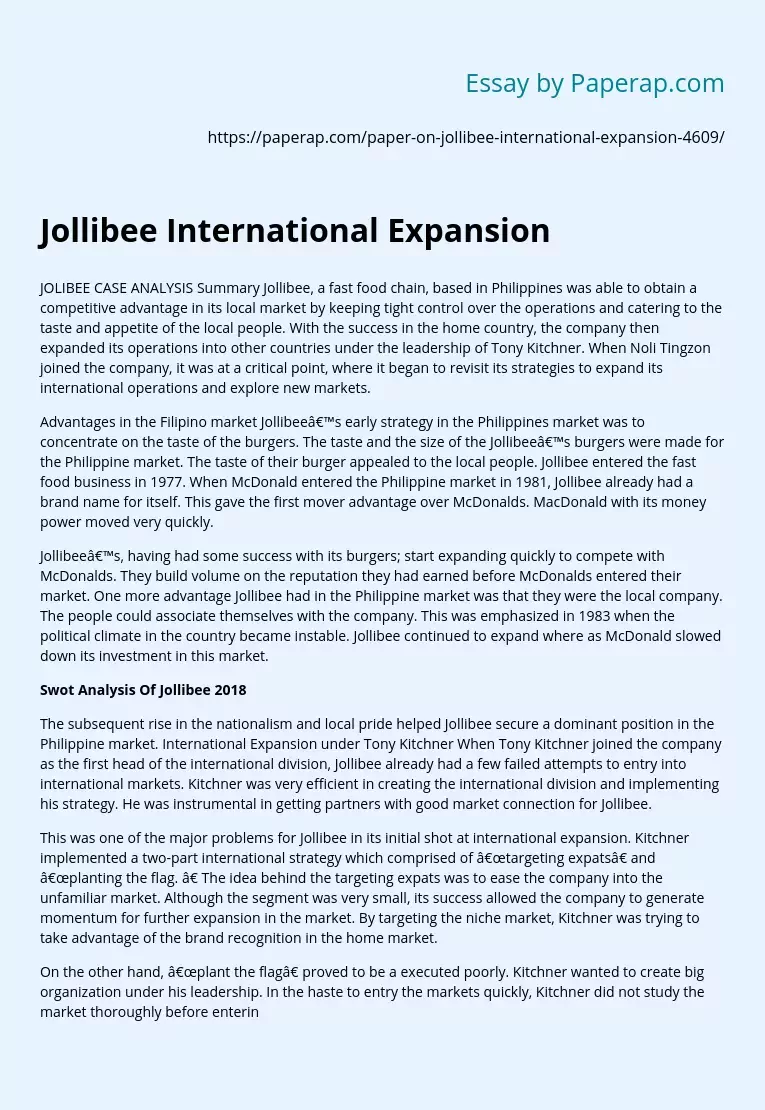Jollibee International Expansion
JOLIBEE CASE ANALYSIS Summary Jollibee, a fast food chain, based in Philippines was able to obtain a competitive advantage in its local market by keeping tight control over the operations and catering to the taste and appetite of the local people. With the success in the home country, the company then expanded its operations into other countries under the leadership of Tony Kitchner. When Noli Tingzon joined the company, it was at a critical point, where it began to revisit its strategies to expand its international operations and explore new markets.
Advantages in the Filipino market Jollibee’s early strategy in the Philippines market was to concentrate on the taste of the burgers. The taste and the size of the Jollibee’s burgers were made for the Philippine market. The taste of their burger appealed to the local people. Jollibee entered the fast food business in 1977. When McDonald entered the Philippine market in 1981, Jollibee already had a brand name for itself.
This gave the first mover advantage over McDonalds. MacDonald with its money power moved very quickly.
Jollibee’s, having had some success with its burgers; start expanding quickly to compete with McDonalds. They build volume on the reputation they had earned before McDonalds entered their market. One more advantage Jollibee had in the Philippine market was that they were the local company. The people could associate themselves with the company. This was emphasized in 1983 when the political climate in the country became instable. Jollibee continued to expand where as McDonald slowed down its investment in this market.
Swot Analysis Of Jollibee 2018
The subsequent rise in the nationalism and local pride helped Jollibee secure a dominant position in the Philippine market. International Expansion under Tony Kitchner When Tony Kitchner joined the company as the first head of the international division, Jollibee already had a few failed attempts to entry into international markets. Kitchner was very efficient in creating the international division and implementing his strategy. He was instrumental in getting partners with good market connection for Jollibee.
This was one of the major problems for Jollibee in its initial shot at international expansion. Kitchner implemented a two-part international strategy which comprised of “targeting expats” and “planting the flag. ” The idea behind the targeting expats was to ease the company into the unfamiliar market. Although the segment was very small, its success allowed the company to generate momentum for further expansion in the market. By targeting the niche market, Kitchner was trying to take advantage of the brand recognition in the home market.
On the other hand, “plant the flag” proved to be a executed poorly. Kitchner wanted to create big organization under his leadership. In the haste to entry the markets quickly, Kitchner did not study the market thoroughly before entering it. Planting the flag did have competitive first mover advantage like the company found out in its local market. However, there is a need to study the market before entering it. The unprofitable venture in the Middle East could have been avoided has research been done prior to entering. Also, Kitchner neglected the high cost of establishing market in new countries.
While Kitchner created the new division to higher international standard there was a growing distance between the local and the international division. The local team were looked down up on by the member in the international division. This did affect the day operational efficiency of the company. Kitchner could have taken some step to curb the growing distance between the two divisions. Future International expansion The undeveloped Papua Guinea market provides the best option to leverage the company’s organizational skills.
However, the country is not big enough to support 20 stores which the company thinks is critical mass for a new country. Even though the perspective partner was willing to invest all the money for the stores, Jollibee would have its brand value at risk if the stores don’t work. The profits being offered by the partner is uncertain and understandably low, the company would be better off staying away from this market. The fourth store in Hong Kong can give Jollibee the brand awareness to expand its operations in the country. This could be useful in attracting better partners.
However given that the current stores were unable to attract Chinese customers as well as employees, the success of a fourth store is highly unlikely. It would be better for Jollibee to concentrate on improving the operations of the current store than opening a new one at this juncture. The Daly City is currently best opportunity for expansion for Jollibee. With a huge affluent Philippine population and relatively less competition prospects for the success of this store were bright. Also, like in Guam, California has a large population of Asian American which the company could target with changing the menu a lot.
Jollibee International Expansion. (2019, Dec 05). Retrieved from https://paperap.com/paper-on-jollibee-international-expansion-4609/

